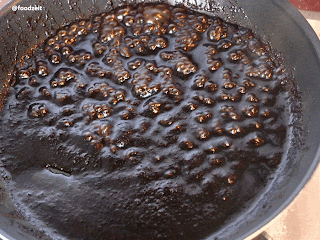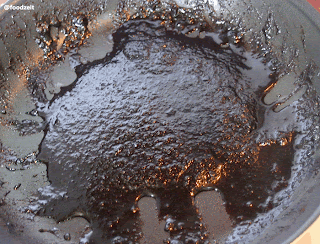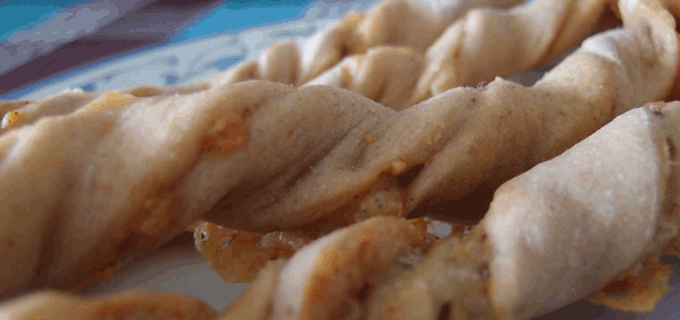 |
| Freshly self made vanilla paste in a jar |
As you already read before, I recently had a great time visiting a vanilla plantation and besides learning a whole lot about planting, harvesting and processing the fresh vanilla, obviously I got a lot of fresh dried vanilla pods back home from
my latest fresh vanilla plantation adventure. I store them in a HUGE jar and the delicious mouth watering smell, every time I open the jar, is just beyond imagination. But as everything natural, also the vanilla pod, if stored too long (don't worry if you are having a few fresh pods at home, I am talking about an effect that will happen if you store the vanilla over many years), it will eventually go dry on you and loose its fresh vanilla smell and aroma. As I bought a few kilo for myself, and I cannot bake so many cakes at once to use them all in time, I thought about a possibility of storing the vanilla differently. One way to do that is to make some vanilla extract using alcohol such as rum or vodka.
You can find the method of doing so in this blog post.
Another way that I will introduce today, which does not use alcohol and for such is also good in kosher and halal baking baking, is the vanilla syrup or better known as vanilla paste. It's a relatively simple and easy way to store the goodness of the vanilla bean and later on you can easily portion the paste for your baking purposes (you can dose the paste as you want while it is difficult to e.g. use 1/5 vanilla pod and store the other 4/5 of the pod). Anyhow, here is the instruction of how to make your own home made vanilla paste.
Ingredients:
- 20 g fresh vanilla beans (should be about 5 A grade fresh pods) or alternatively you can take vanilla powder (which is nothing else then grated whole vanilla beans)
- 60 g sugar
- 60 ml water
- tsp. juice of half a lime
 |
| Ingredients: Lemon, sugar and vanilla powder / pods |
If you are using the whole pods, throw them together with the sugar in your kitchen aid and grind them to a fine powder. The rest is relatively easy. Throw all the ingredients in a saucepan or in a pot.
 |
| Ingredients in the saucepan |
The bring the whole thing to a boil. Here is a warning. The whole of your kitchen is going to smell awefully delicious while your are cooking your pods, it always gets my stomach grumbling. So be sure you have eaten something before :). Ok now you cook everything for a few minutes until the water is reduced and you get something like a syrupie mass like you can see on the pictures.
 |
| Vanilla paste boiling and simmering |
 |
| reduced paste ready for botteling |
Now I fill everything in a sterilized glass container. Try to be accurate and scratch everything from your pot or pan as you don't want to even loose a drop of this goodness.
 |
| Freshly homemade vanilla bean paste in the jar ready for baking |
It's ready for baking now. When you do so, please pay attention. Your paste is packed full with flavors and much more intensive then any of the vanilla extract or vanilla sugar that you can buy from the shelf. So if you re baking something and following any type of recipe, try to carefully measure the addition of your paste to not overpower everything with the vanilla paste by putting too much of it, so don't just replace vanilla sugar content or vanilla extract content in the recipe by vanilla paste on a 1:1.
Last but not least, not everybody can travel to the vanilla plantation and buy a lot of vanilla pods like I did. But you can get your vanilla simple and easy online. You can for example get best quality grade vanilla for a very attractive prize and support my partner that is trying to set up some shop in which you can buy fair traded vanilla that comes directly from the farmer. The shop is called
Low Lands Import and they sell on Dawanda and other portals.

















ich werd mich mal umschauen nach deiner Bezugsquelle- Vanille ist eins meiner liebsten Gewürze und ich kaufe bislang über die Apotheke gemahlene Schoten....
ReplyDeleteGanz ehrlich gesagt, bis vor kurzem kannte ich die echte Vanille gar nicht. Ich habe meistens mit künstlichen Aromen gearbeitet, aber ich wusste ja auch noch nicht was mir entgeht. Seit ich zum ersten Mal richtige Vanille probiert habe werde ich nie wieder was anderes verwenden und bei vielen Gerichten überlege ich mir oft ob dazu nicht was mit Vanille passen würde.
ReplyDeleteDie gemahlenen Schoten, welche Du erwähnst, ist das was ich zum Herstellen der Paste genommen habe (oben auf dem Bild), richtig? Für das gemahlene Pulver werden normalerweise die C Grade Vanille Schoten genommen denn die A und B Grade Schoten sind zu teuer um diese zu Pulver zu verarbeiten (die solltest Du mal versuchen wenn Du die Gelegenheit hast). Der Unterschied zwischen den A Grade Schoten und den B Grade Schoten ist nicht so groß, die A Grade Schoten sind halt länger und schöner aber vom Geschmack her gibt sich das nichts.
Mit dem echten Vanillezucker kam ich in der Apotheke in Berührung und seitdem gibt es nix anderes mehr- allerdings ob man eine Chance hat hier an die höher-gradigen Schoten zu kommen- mal schauen. Dein Link gibt auch Grad C an.
DeleteJa, das kann ich nur bestätigen, einmal richtige Vanille probiert und man will nichts anderes mehr. Ging mir genauso so. Ja, C Grad sind die kleinsten Schoten die manchmal auch kleine optische Mängel haben können (gesplittete Schoten, leichte Oberflächen Mängel). Durch einen leicht unterschiedlichen Prozess bei der Herstellung ist der Geschmack der C Grad Vanille nur ein bisschen weniger intensiv als A oder B Grad Vanille. Ich nehme die C Grade vor allem wenn ich selber Vanillezucker, Paste oder Extrakt herstellen will und die A und B Grad Vanille wenn ich was backen will.
DeleteThank you so muchhhhhh for this vanilla bean paste recipe. I've been looking for the recipe without any alcohol. Do you have any idea how long it can last?? What about the proper storage?? Do i need to refrigerated it??Take care and god bless.
ReplyDeleteThank you very much for your comment and I am happy you like this recipe. For your question now. Honestly? It never really lasted that long when I made some cause I used it up rather fast. But you can use sterilized glass containers and put the glass containers, after filling them in a water batch at 70 degrees for 50 minutes. That sterilizes them and creates a vacuum and you should be good for having this for years to come. Once you open them up I can only guess so far but keeping it in the fridge will of course lengthens the shelf live of your bean paste.
DeleteThe ingredient list calls for a lime, but the picture shows a lemon. Which should be used?
DeletePlease take a lime if you can get it, i took a lemon cause lime was not availiable
DeletePlease take a lime if you can get it, i took a lemon cause lime was not availiable
Delete